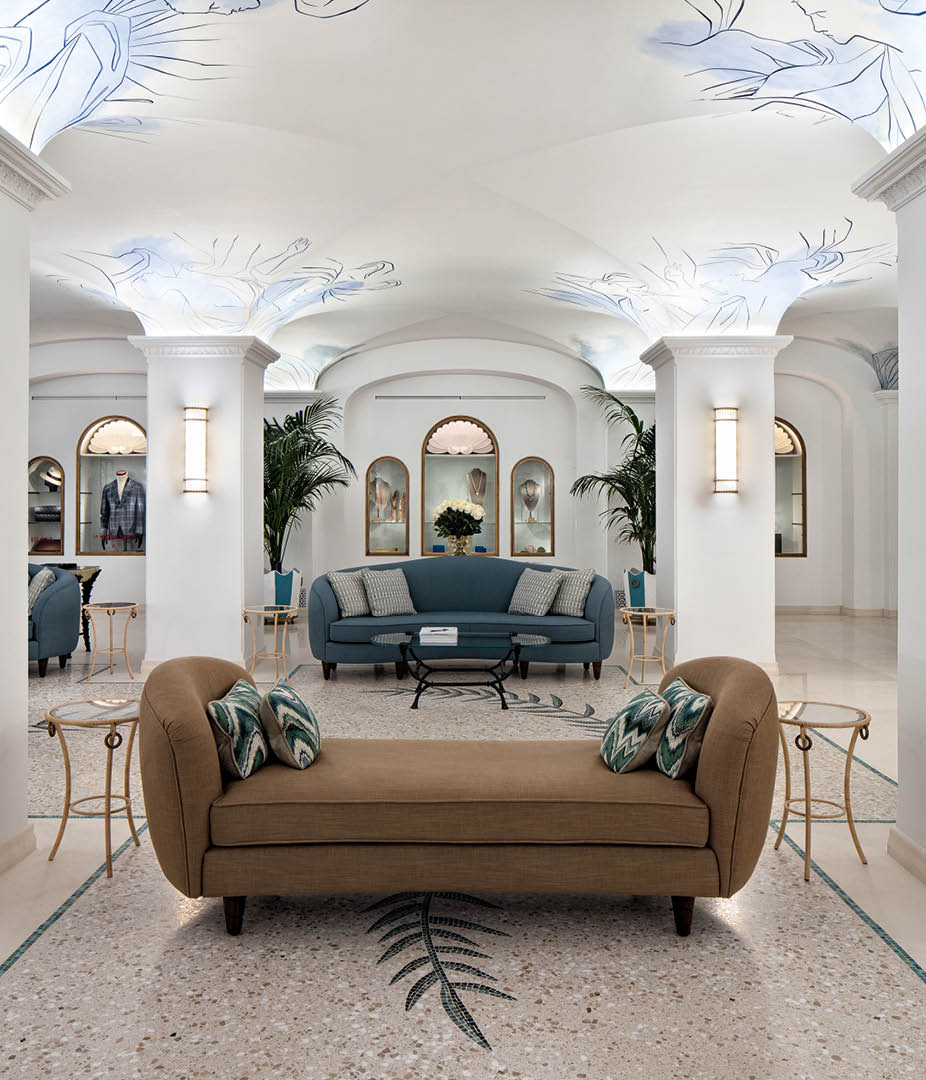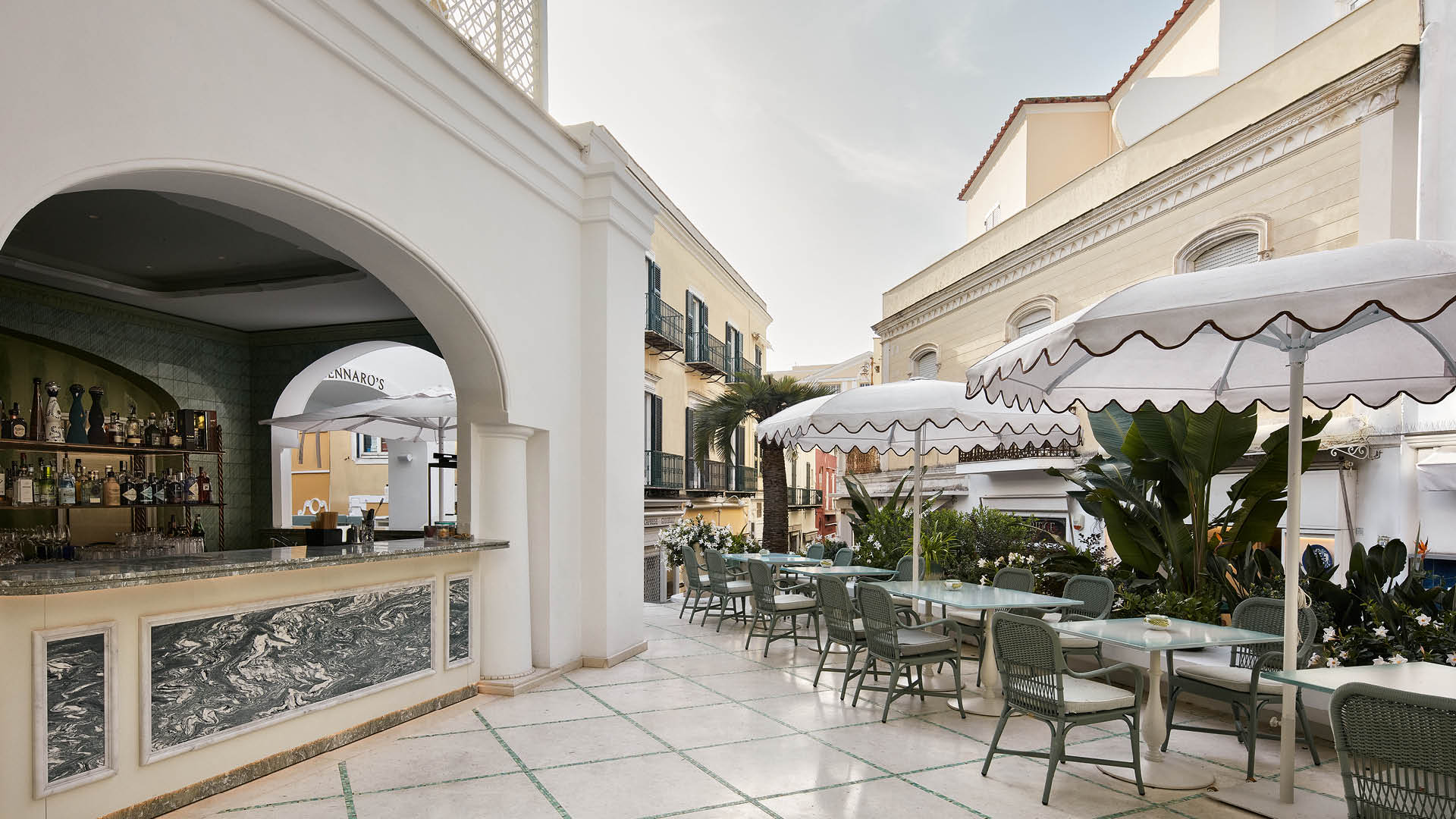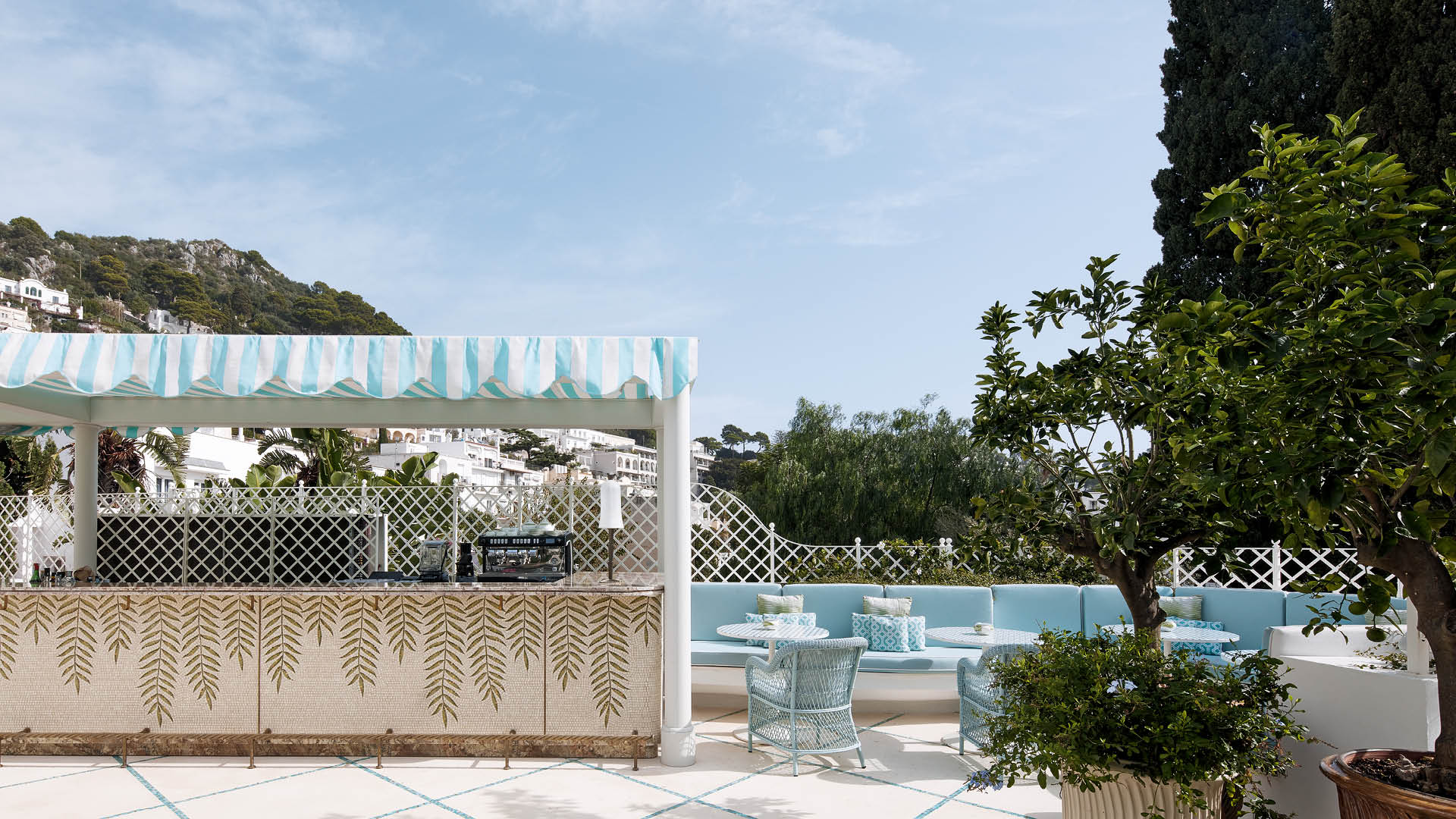- Category
- Hospitality
- Location
- Capri, NA, Italia
- Year
- 2023
- Architect
- Francis Sultana
- Builder
- Oetker Collection
Hotel La Palma is located in Capri, a few steps from the famous Piazzetta. A mythical place of Mediterranean summers, it has rediscovered the splendours of the past, thanks to the recent redesign curated by Francis Sultana.

Hotel La Palma is an exclusive and elegant Mediterranean retreat. The building, built in 1822, is located a few steps from the Piazzetta – an iconic place of Italian summers. The hotel reopened in 2023, after a renovation that lasted almost three years.
Francis Sultana, an interior designer who works on the border between design and art, designed the project for Oetker Collection, one of the largest hotel groups in the world. To ensure that the new hotel faithfully reflects the spirit of the place, everything has been tailor-made by Italian and local artisans.
Designed to be a cosy home away from home, the La Palma hotel expresses discreet luxury through obsessive attention to detail.

Francis Sultana is one of the world’s foremost interior and furniture designers – he is featured in Architectural Digest US magazine’s annual AD100, cited as one of Wallpaper’s Top 20 Interior Designers and listed on House & Garden and AD Italia’s Top 100.
He is also the artistic director of the renowned David Gill Gallery of London, sits on the Victoria & Albert Museum’s Advisory Council, and has institutional roles in Serpentine Galleries and the Design Museum of London. Design and art are so intertwined in his life, that the ability to merge them in his interiors has become one of his peculiarities, as well as having a strong interest for artisanal skills and techniques. Hotel La Palma, Sultana’s first hotel project, stems from the designer’s love for Capri, one of his favorite holiday spots, an island that reminds him of his birthplace, Malta.
You recently renovated Hotel La Palma, the oldest hotel in Capri and your first ever hotel project. Where did you start from?
I’ve known Capri for more than 25 years, I’ve been going there every summer, so the most important thing was the inspiration it has given me. Thinking about the building and its historical references, I wanted to bring it back to its original narrative, complementing the architectural history with something up to date, restored and conserved for the future.
How would you describe Capri?
I grew up in Gozo, the small island off the coast of Malta, so I know very well how an island like Capri works, and that’s why I am very fond of it. Capri is unique, it is neither part of the mainland, nor of the Amalfi coast, even if it has the same influences. It is in its own bubble, it has always been a place of beauty that attracts people. It has its own way of dealing with things, its own way of survival. Even the people are very different: they look after themselves and their island in a way that is different from all the other islands around. It’s such a special place.
You said in an interview that: “an interior design project is successful when one is able to read the space”. What is the vocation of Hotel La Palma?
Hotel La Palma is located in the middle of Capri, near the Piazzetta, so it really lies at the core of what Capri represents. I wanted the hotel to look like a villa and feel like a home. In a way, my experience in designing homes shines through, but what is new is that with a hotel I have to please not just one family but all the different people who come every season, people from all over the world and Italians themselves. It’s been a very interesting and challenging way of decorating, also thinking about the historical context of the Italian style, and the Italian way of doing things. I wanted people to feel comfortable, and to feel that the place is appropriate. An appropriate, elegant hotel that blends in well with Capri, as if it has always been there.
La Palma is a luxury hotel: what does luxury means today?
I think the most successful luxury interiors today are low key and very sophisticated, which is actually the most difficult thing to achieve, because understated decoration can be very expensive, even if you wouldn’t say so by looking at it. But the quality is there, the design is there, and the history is there. It is the most difficult route to take when decorating nowadays. There are designers in every country who are very focused on this, and I am one of them. We are a small group with a very defined identity, style and point of view, and every project we do challenges us to excel.
You designed everything, from the furniture to small details: what is the role of craftsmanship in this project?
I designed maybe 90% of everything inside Hotel La Palma, which is a very high number, and I had this vision that it had to be made in Italy. My designs are good, but unless they’re made authentically, with the surrounding environment in mind, they are not strong. So craftsmanship is key. If a great jacket were made by a bad tailor, it would be a bad jacket, but if it were made by a good tailor, it would be a very beautiful jacket. It’s the same. Italy is a place where fashion and furniture design are especially strong, and it has a history of quality. I think this is why my work turned out beautifully.
“I wanted people to feel comfortable, and to feel that the place is appropriate. An appropriate, elegant hotel that blends in well with Capri, as if it has always been there.”

Do you have a favorite piece?
I don’t have one, because for me the building is one thing, it’s one entity. The whole thing is my favorite thing. I’ve had guests saying: “I love this chair, I love this handle, I love that…”, but for me as a designer there is just one harmonious design.
How did you use colours?
Everything for me has a narrative of the locality when it came to colour. Of course, there is a lot of white, because white – bianco – is all around in Capri: houses are white, it is the colour of calmness. Then there are the aquas, the pale greens, the limone – I used what I saw around me, the colours that make me happy when I’m in Capri. So, my palette was white, with these accents of the colours I picked out, which are true to the environment.
What was Poliform’s contribution to the project?
I had no experience with working with Poliform until this project. What I was very taken aback by was that my designs are very different to what Poliform retails and what people know them for, even if obviously they are committed to quality, good materials and good execution, so we share the same goals. A lot of my designs draw inspiration from 1920s, ‘30s antique furniture, especially
from Art Deco, and contemporary design has a very different narrative. What was interesting for me was that when I started to see the prototyping, I became very engaged with them, I got very excited. They brought the artistry in: when I wanted molded items, when I wanted mosaics, when I wanted all these things, they engaged with it very well at all different levels. We grew together, and I think we all very much enjoyed the process of creating something which for both parties was new. I think the collaboration was a very good one, we both felt that we did something for us that is another stepping stone in the way that we both work.
What about the counters in mosaic: what was the concept and how did you develop it?
They were all made in Italy by Poliform. The ones on the rooftop are inspired by the caftans that the ladies wear in Capri, I was thinking of vintage Missoni, or Valentino, but also the exoticism in Renzo Mongiardino’s design. Then there are palms, which are part of the overall signature, as are the colors of Capri: the palm is of course for La Palma, and I used it for mosaics on the floor, on the counters, and on handles. I wanted the mosaics to be artisanal, and not made in a factory, I mean, it was haute couture, and when I saw the first samples I was so happy because it was great that the people at Poliform understood my designs so well, it meant they understood me.
You are loved as an interior designer for the ability to merge design with visual art, sculpture and installation pieces: what pieces did you choose for Hotel La Palma?
La Palma was a hotel for artists when it first opened, so I wanted this history to continue. And I think contemporary art is very important in anyone’s environment, it has a very big role in all our lives. Again, I wanted Italian artists because we’re in Italy. The artworks in the rooms were done by Milanese artist Luisa Lambri. She created these small precious images, sort of additional windows with views of Capri and Amalfi, to give guests something to aim their sight at, and at the same time infuse a sense of calmness. In the lobby, ceiling frescoes are by Roberto Ruspoli. Every season from now on there will be a new show, and the hotel will acquire some new artworks every year, so its collection will change and develop. I think this gives a unique style to the hotel, an individuality that is very sophisticated and is getting rarer in the hospitality business today. I’m very happy that I was there to lay the foundations of an art project like that, and that both the Ruben Brothers and Oetker love the idea that art becomes very much part of what this hotel is.
What was people’s reaction to the project?
La Palma is my first hotel, so I was quite nervous to see the reaction of people. But from what we know and have read in the first few months, it’s been a big success, for me but most of all for Oetker and the owners. There was a lot of love, a lot of generosity in people’s praise for the hotel and for me as a designer. One of the most important elements was the recognition I got from the people of Capri. They were nervous about the hotel, about an international company with an international designer coming in and putting something modernist perhaps or that doesn’t fit in. They all loved the hotel, I gave them something that has the essence of Capri, showing that conserving the architecture, restoring it, looking after it, bringing it up to date, creates a new authenticity to the place. I’m so happy I was given this opportunity, it was fate that this hotel, my first, is in one of my favorite places in the world.






















